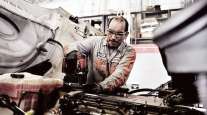Proper Engine Maintenance Necessary to Extend Life of DPFs, Managers Say
This story appears in the May 26 print edition of Transport Topics.
Diesel particulate filters, a key element of truck emissions systems since 2007, can present fleets with problems if they are not routinely maintained along with the truck’s engine, experts said.
“If the engine isn’t maintained properly, it will go into regeneration more times than it needs to. In that case, your [DPF] gets clogged up quicker than it should,” said Michael Buck, the principal at MCB Consulting in Kansas City, Kansas, and a former maintenance executive with Con-way Freight and UPS Inc.
Regeneration is the process of removing excess soot from the filter. If a DPF — which is used in engines with selective catalytic reduction as well as those with exhaust gas recirculation — becomes clogged with ash and soot, the unit has to be taken off the truck to be cleaned.
Tim Moore, senior director of maintenance for Watkins Group, a refrigerated carrier in Lakeland, Florida, said ash accumulated during DPF usage can’t be burned off because it’s a byproduct of regeneration heat.
“You can’t burn the ash; it’s already burned.” he said.
Roadwarrior, in The Woodlands, Texas, and a unit of DPF maker DCL International Inc., said on its website that proper maintenance of DPFs “will help reduce back pressure and improve fuel economy.”
“An extra . . . DPF can be used as an ideal swing unit to avoid any unnecessary downtime while a DPF is being cleaned,” said David Jerman, Roadwarrior’s product line sales manager. “Proper DPF cleaning may require the unit to be baked, which can cause typical delays of at least one to two days.”
Many carriers, such as the Watkins Group, are having their DPFs cleaned by outside companies, including dealerships.
However, that is creating another problem.
With several thousand new trucks that use diesel particulate filters sold each month joining the hundreds of thousands in use, truck dealers and companies that clean DPFs are overwhelmed, industry experts said.
“You’re starting to see the dealer network become overwhelmed because at 200,000 miles, for some companies, that’s a little over a year of driving, said Tim Moore, senior director of maintenance for Watkins Group.
Moore said 200,000 miles is the interval at which he has his DPFs cleaned.
The number of Class 8 trucks with DPFs is increasing by about 30,000 a month, making it hard for dealerships to keep up with the service demands, said Drew Taylor, vice president of global marketing at FSX Equipment Inc., which is based in Granite Falls, Washington, and sells equipment for cleaning DPFs.
“I see a real problem developing,” Moore said. “It kind of builds on itself, and the next thing you know, your boat’s full of water and maintenance managers spend a lot of time explaining elevated costs due to the emission systems to company ownership.”
But a large part of the problem caused by dirty DPFs can be mitigated by fleets.
MCB’s Buck said that deferring tuneups and maintenance on such things as air cleaners, fuel filters and testing of diesel exhaust fluid (which can be affected by light and temperature) prevents the engine from operating properly, causing excessive regeneration.
Ash left behind in the cells after an incomplete cleaning will form “a hardened ash island” that increases engine back pressure and can permanently damage the DPF, Taylor said.
About 6,000 intake cells in a DPF are used on a Class 8 truck, he said. “Think of 6,000 little garbage cans, all needing to be cleaned because ash never oxidizes.”
Back pressure from an ash-plugged DPF can reduce fuel efficiency by as much as 5%, Taylor added. “That’s expensive, all because you left the ash in your DPF.”
In response to dealers’ DPF cleaning crunch, some larger fleets are taking over the DPF cleaning function, Taylor said.
If fleets have a rigorous periodic maintenance inspection process, use the proper low-ash oil appropriate for their engines’ duty cycles and follow engine manufacturers’ recommended practices at reasonable service intervals, then properly maintaining an SCR engine will not be an issue. Buck said maintenance should include daily monitoring and documentation by the operator, and periodic inspections and scheduled routine maintenance that lubricates, adjusts, repairs, or replaces critical components at an interval that maximizes the life of the component as well as the efficiency and availability of the asset.
Terrell Dodgins, truck maintenance supervisor at Crane Transport, a dry freight and refrigerated carrier based in Gainesville, Georgia, said he keeps his eye on several factors in an SCR aftertreatment system.
“There are some components that are pretty tricky, like the computer modules [to regulate the dosage of diesel exhaust fluid in the SCR component] that we don’t have access to,” he said. “If you have a problem with it, that’s going to have to go to the dealer.
“Most of the time, I like to look at the DPF around 180,000 to 200,000 [miles], but I don’t like to push it because if the truck is out on the road [and there is a problem] you don’t have any control over it,” Dodgins added. The carrier keeps its trucks until they reach about 450,000 miles.
Crane’s strategy is to “clean [the DPFs] twice and when you go to trade them in, they should be clean as whistles and good to go.”
“Think about the guy who has 5,000 trucks. That’s a lot of DPF [replacement cores] to keep on the shelf. Last time I checked, they were still $2,100 to $2,300 purchased new,” Watkins’ Moore said.
According to the Environmental Protection Agency’s Diesel Particulate Filter Operation and Maintenance technical bulletin, “It is important to properly maintain vehicles and monitor fuel and lubrication oil consumption. A bad fuel injector or increase in oil consumption may be masked by a DPF. The DPF may be damaged by a poorly maintained engine. When a DPF is removed for cleaning, it may be useful to check the opacity of the vehicle to determine if a potential engine problem exists. Maintaining service records is advisable to track potential concerns or changes in operation.”
Diesel emissions fluid also is important in DPF maintenance.
“The quality of your DEF is a major, major component. If you have poor quality DEF, you are going to have a lot of trouble,” Dodgins said.
Experts said DEF is supposed to consist of 67.5% deionized water and 32.5% automotive-grade urea. The purity of the mixture affects the performance and life of the SCR aftertreatment system, while the proper concentration of liquids is crucial to NOx reduction.
“Impure DEF can cripple equipment and lead to staggering amounts of downtime and de-lays,” according to DEF supplier Old Word Industries, of Northbrook, Illinois.
MCB’s Buck said bad DEF shows up with some distributors who come in at lower prices for people who don’t know the difference in quality.
Buck said he was pricing DEF for a client and found the bulk price per gallon ranging from $1.40 to $2.24. He tested the quality in various DEFs and found there was a great variety.
The client decided to buy the DEF priced at $1.60 per gallon even though he had been paying $1.40 per gallon. “But the client is now experiencing fewer messages to check for poor DEF and fewer regenerations of the DPF,” Buck said.
Chuck Remington, maintenance director at Marten Transport, based in Mondovi, Wisconsin, said its DEF supplier, Terra Environmental Technologies in Deerfield, Illinois, insisted that the fleet meet storage-tank standards before it would deliver DEF. Marten ranks No. 42 on the Transport Topics list of the 100 largest U.S. and Canadian for-hire carriers.
“You need to guarantee maintaining product purity. Using only DEF-approved piping and pump/dispensing systems will ensure this,” stated another DEF supplier, Airgas Specialty Products in Lawrenceville, Georgia.
Brad Williamson, manager of engine and component marketing for Daimler Trucks North America, advised fleets using Detroit engines to fill the diesel exhaust fluid pump air bladder to 40.6-46.4 pounds per square inch every 24 months, change the DEF pump filter every 150,000 to 250,000 miles, and inspect the aftertreatment system’s external hardware and connections every six months.
Navistar Inc. spokeswoman Elissa Maurer said the onboard diagnostic tools can alert drivers to potential engine issues that, if unresolved, might affect the operation of the DPF system.
“Drivers that pay attention to their vehicles’ diagnostics will stay ahead of most issues,” Maurer said.
Truck manufacturers Volvo Trucks, Mack Trucks Inc. and Paccar Inc. did not respond to request for comment.




